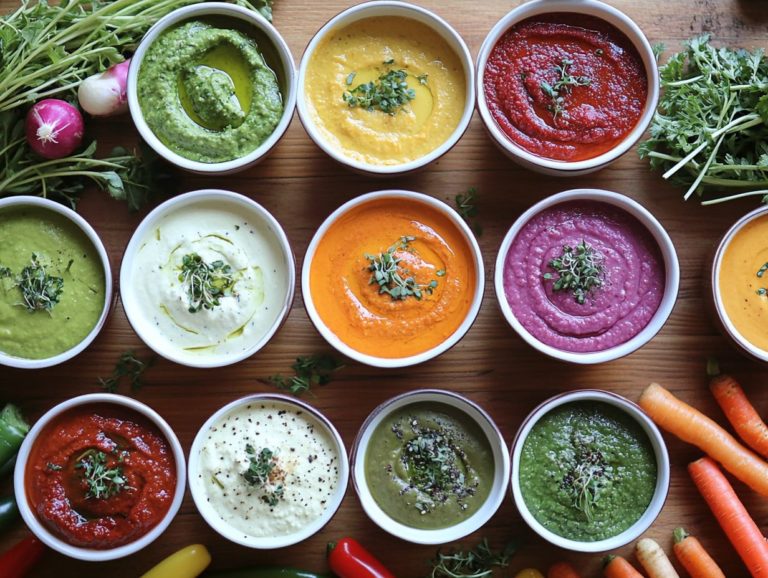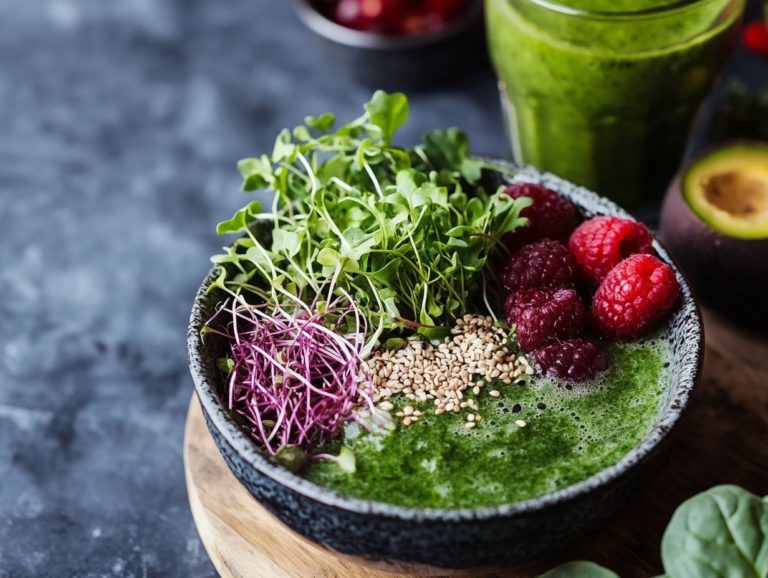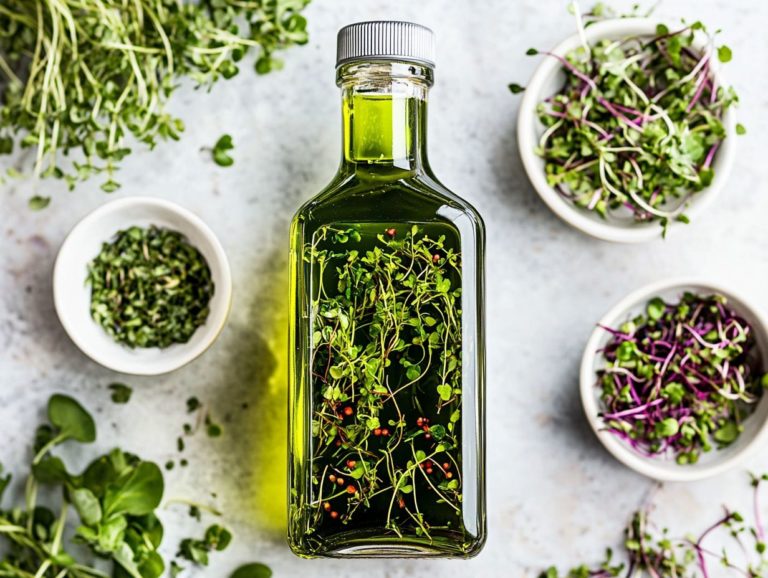92. Microgreens in American Cuisine: A Recipe Guide
Microgreens are not just petite plants; they re tiny flavor powerhouses that have taken American cuisine by storm. With their remarkable nutritional benefits and vibrant appeal, these miniature greens transcend the role of mere garnishes they truly shine as culinary stars.
This article will explore the advantages of incorporating microgreens into your meals, provide insights on how to cultivate them at home, and share delectable recipes that will inspire your cooking skills.
Whether you’re an experienced chef or just starting out, you ll discover valuable tips on selecting, storing, and utilizing these nutrient-rich gems to elevate your dishes to new heights, especially in vegetable dishes and healthy meals.
Contents
Key Takeaways:
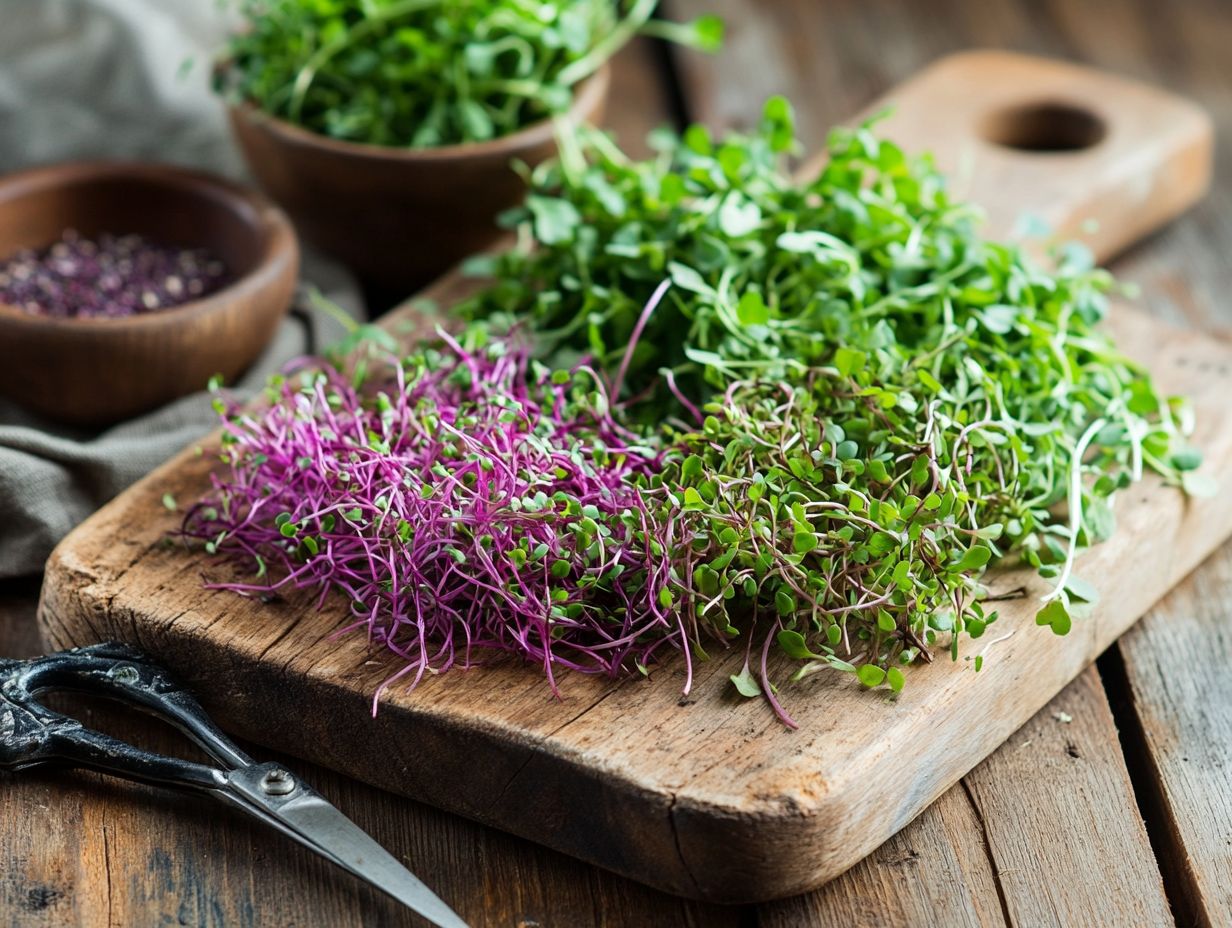
- Adding microgreens to American cuisine provides numerous health benefits due to their high nutritional value.
- Growing microgreens at home is simple and cost-effective.
- Microgreens are game-changers in the kitchen, enhancing flavor and visual appeal.
What are Microgreens?
Microgreens are young, edible plants harvested just after the first set of leaves appear. Bursting with flavor and nutrients, these tiny greens can include a delightful array of species like arugula, borage, and pea shoots. They re becoming increasingly popular in salads, sandwiches, and as garnishes.
Their versatility in the culinary world is impressive. Whether you re tossing them into soups, blending them into smoothies, or using them as vibrant toppings on hearty sandwiches or burritos, they truly shine.
These miniature powerhouses deliver a concentrated dose of vitamins, minerals, and antioxidants, often packing more nutritional punch than their fully grown counterparts. With various options available, you can easily find microgreens that suit your taste preferences, whether you favor sweet, spicy, or earthy flavors.
The best part? They can be grown using simple methods like hydroponics a method of growing plants in water without soil soil cultivation, or even right on your kitchen window sill, making them an accessible choice for anyone passionate about healthy eating.
Chefs and home cooks alike have started to recognize how microgreens can elevate their dishes, both in presentation and nutrition. They offer a quick and fresh way to enhance flavors and boost overall wellness, making them a must-have in your meal planning. Exploring unique microgreens to elevate your dishes can add an exciting twist to your culinary creations.
Benefits of Incorporating Microgreens in American Cuisine
Incorporating microgreens into your cooking opens up a world of benefits. These vibrant greens, packed with vitamins and minerals, elevate everyday meals, transforming them into healthier options and visually stunning presentations.
Whether you sprinkle them atop salads, layer them in sandwiches filled with fresh vegetables, or garnish your guacamole, microgreens like arugula and mustard can turn any dish into a culinary masterpiece. For a deeper dive, check out this quick guide to common microgreen varieties while supporting local farming with fresh, homegrown produce.
Health Benefits and Nutritional Value
Microgreens are celebrated for their remarkable health benefits and nutritional value, often boasting higher concentrations of vitamins and minerals compared to their fully grown counterparts. Take broccoli and kale microgreens as examples; they are packed with potent antioxidants, while pea shoots shine with vitamins A, C, and K. This impressive nutrient density makes them a smart addition to your diet, especially if you re health-conscious and eager to enhance your meals effortlessly.
Incorporating microgreens into your recipes can significantly elevate the nutritional profile of your everyday dishes. These tiny greens are not just visually appealing; they re also an excellent source of folate and iron, boosting your overall energy and vitality.
Whether you re a seasoned chef or a home cook, you can effortlessly toss them into salads, blend them into smoothies, or use them as a vibrant garnish atop soups and sandwiches. Their versatility adds a delightful crunch and flavor while delivering a powerful punch of essential nutrients, making them essential for a healthier lifestyle.
How to Grow Microgreens at Home
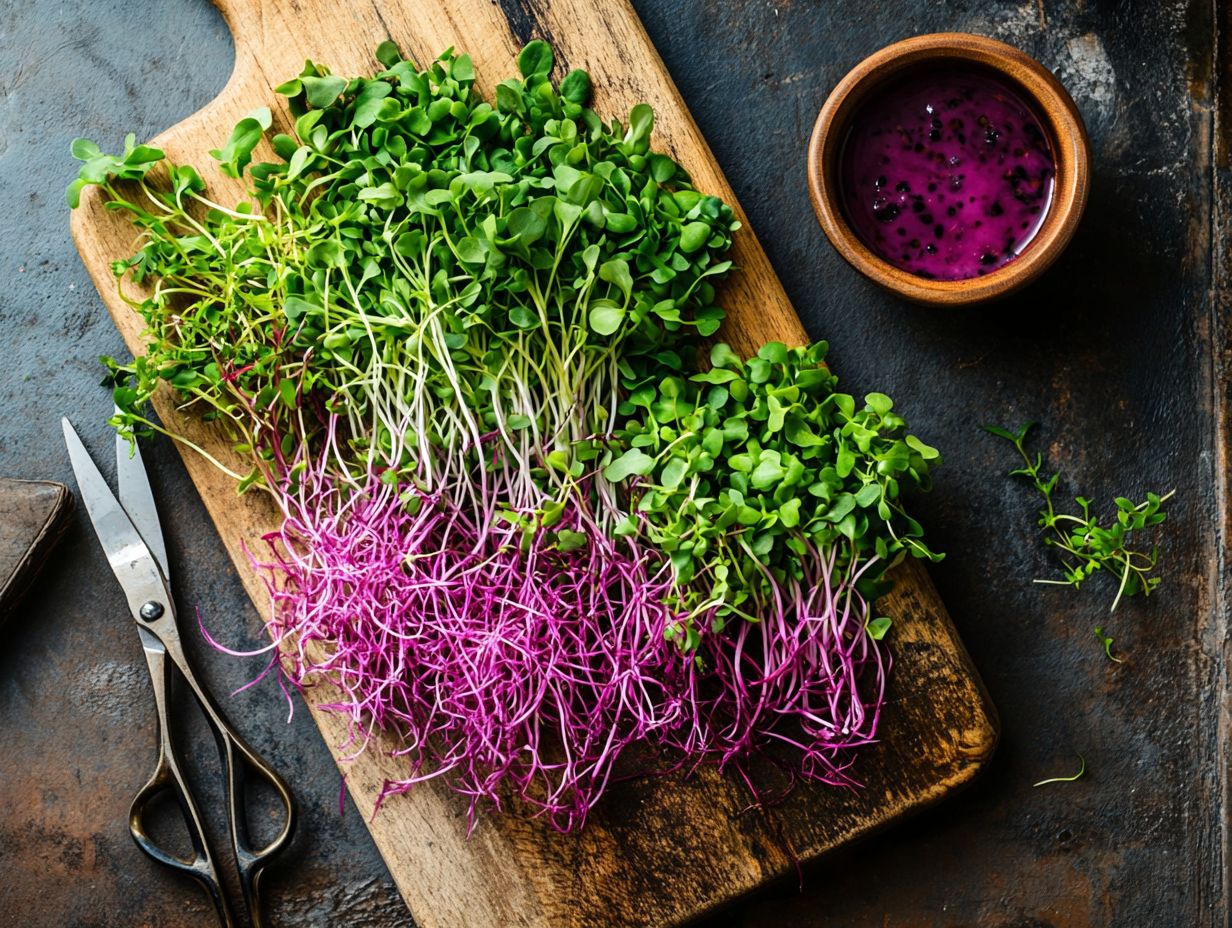
Growing microgreens at home is accessible and a truly rewarding experience. You can savor fresh, nutritious greens whenever you desire. With just a handful of basic supplies seeds, soil, and a shallow tray you can cultivate an array of microgreens right in your own kitchen.
The journey begins with selecting the right seeds. Carefully provide them with the necessary water and light. Timing your harvest perfectly will maximize both flavor and nutritional benefits.
Step-by-Step Guide to Growing Microgreens
To start your journey of growing microgreens, begin by selecting the right seeds, such as arugula or mustard. Next, choose a suitable container and soil to create the ideal environment for growth.
Start by soaking your seeds. Then, place them on the moist soil, lightly covering them to retain that precious moisture. Ensure they receive adequate light from sunny windowsills or grow lights.
Water them consistently to avoid drying out, as these factors play a pivotal role in germination and growth.
Once you have your initial setup, keep a close eye on the temperature. Aim to maintain it between 65 to 75 degrees Fahrenheit for optimal conditions.
As the microgreens begin to sprout, remember to thin them out. This enhances air circulation and helps prevent any pesky fungal issues. Regularly inspect for pests, as their unwelcome presence can create challenges. A gentle organic pesticide can help you here.
When your microgreens reach a height of about 2-3 inches, it’s time for the harvest. Cut the greens just above the soil line and give them a light rinse before serving. Revel in the fresh flavors and nutritional benefits that these vibrant greens bring to your meals!
Popular Microgreens in American Cuisine
In American cuisine, you ll find a delightful array of popular microgreens that bring a symphony of flavors and textures to your table. Varieties like arugula, borage, and pea shoots are at the forefront of this trend, captivating chefs and home cooks alike.
These vibrant greens also add a stunning visual flair to your dishes. They infuse meals with unique flavors that can truly elevate your everyday cooking. For those new to this culinary trend, exploring microgreen varieties: a guide for beginners can be invaluable. Integrating these microgreens into salads, sandwiches, and garnishes has become a hallmark of refined cooking, making them essential in the art of gastronomy.
Types of Microgreens and Their Uses
There are countless varieties of microgreens, each boasting distinct flavors and culinary applications that can elevate your meals to new heights. These delicate greens enhance the visual appeal of your dishes and are brimming with nutrients, making them a wise addition to your diet.
For instance, radish microgreens introduce a spicy kick that can elevate your sandwiches. Meanwhile, basil microgreens lend a sweet, aromatic flair that is perfect for pasta dishes and pestos. To explore more about different options, check out the microgreen varieties: taste and flavor guide.
If you’re looking to infuse your breakfast with a vibrant burst of color and flavor, consider sunflower microgreens. They can truly brighten up your omelets or avocado toast. It s astonishing how these tiny greens have the power to transform an ordinary dish into something extraordinary, delighting both the palate and the eye.
Recipes Using Microgreens
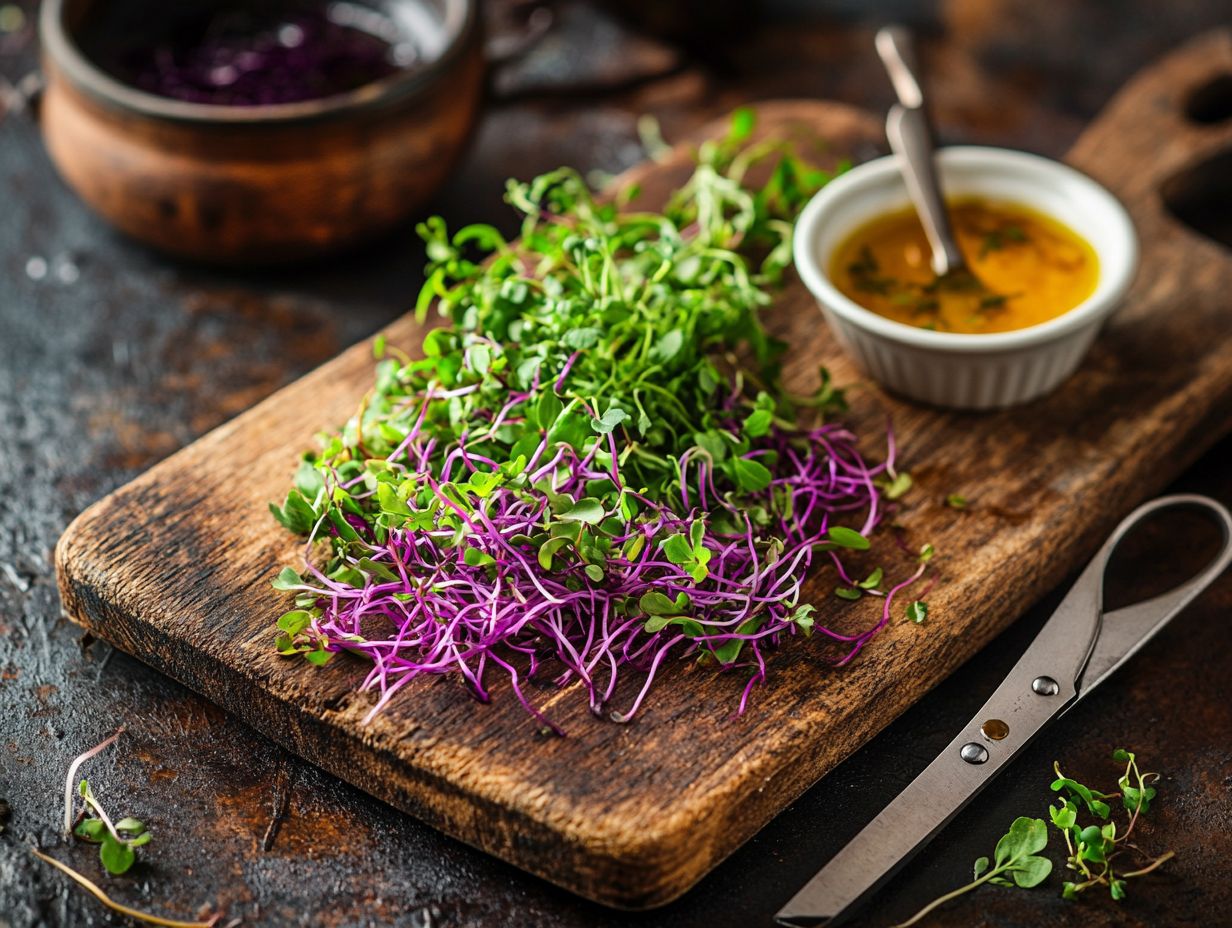
Recipes featuring microgreens are exciting and invite you to explore a world of diverse flavors. These can range from crisp salads to satisfying sandwiches.
Imagine a vibrant quinoa salad adorned with arugula microgreens both nutritious and a feast for the eyes. Or picture tacos brimming with creamy guacamole and dusted with pea shoot microgreens, delivering a delightful twist that surprises the palate.
These petite greens can even enhance your smoothies and drinks, offering a nutrient-rich boost that elevates the overall flavor without overwhelming it.
Are you ready to transform your meals? Start your microgreen journey today by exploring microgreen varieties for culinary professionals and enjoy fresh greens in your dishes!
Delicious and Creative Ways to Use Microgreens in Dishes
There are countless delicious ways to incorporate microgreens into your daily diet, transforming simple dishes into tasty meals. Tossing a handful of microgreens onto your sandwich can elevate its flavor, while using them as a garnish for soups or grilled vegetables enhances both taste and presentation.
You can easily add them to dressings, smoothies, or even desserts, showcasing their remarkable versatility in the kitchen.
Microgreens shine in salads, adding a vibrant burst of color and depth with minimal effort. Imagine a stunning microgreen salad drizzled with citrus vinaigrette, where the freshness of the greens harmonizes beautifully with the dressing.
For brunch, brighten up your omelets or avocado toast with a sprinkle of fresh microgreens, adding nutrition and flair. If you re feeling adventurous, try infusing microgreens into creative cocktails for a delightful twist.
By exploring these diverse applications, you ll see how microgreens not only enhance flavor but also elevate the overall aesthetic appeal of your meals.
Tips for Buying and Storing Microgreens
Choose fresh microgreens for the best flavor and nutrition. Look for vibrant, crisp greens with no signs of wilting or discoloration.
After making your selection, proper storage is key. Keep them in a container that allows air to circulate in the refrigerator to maintain quality and extend shelf life.
How to Choose and Keep Fresh Microgreens
Choosing and keeping fresh microgreens requires a discerning eye for quality and thoughtful storage methods. When selecting microgreens, look for those that are vibrant and free from blemishes or wilting.
Using a breathable container in a cool environment, like your refrigerator, will help preserve their freshness and nutritional value for a longer time.
Harvesting them in the morning, when their moisture content is at its peak, results in a more robust flavor and texture. Consider sourcing microgreens from local farms or farmers’ markets for fresher options.
Each variety offers unique textures and flavors arugula has a peppery kick, while basil delivers a delightful sweetness.
Remember, humidity is key; if your microgreens are too wet, they can spoil quickly. Gently patting them dry before storage can work wonders. By following these practices, you can truly savor the full benefits of these nutrient-dense ingredients.
Frequently Asked Questions
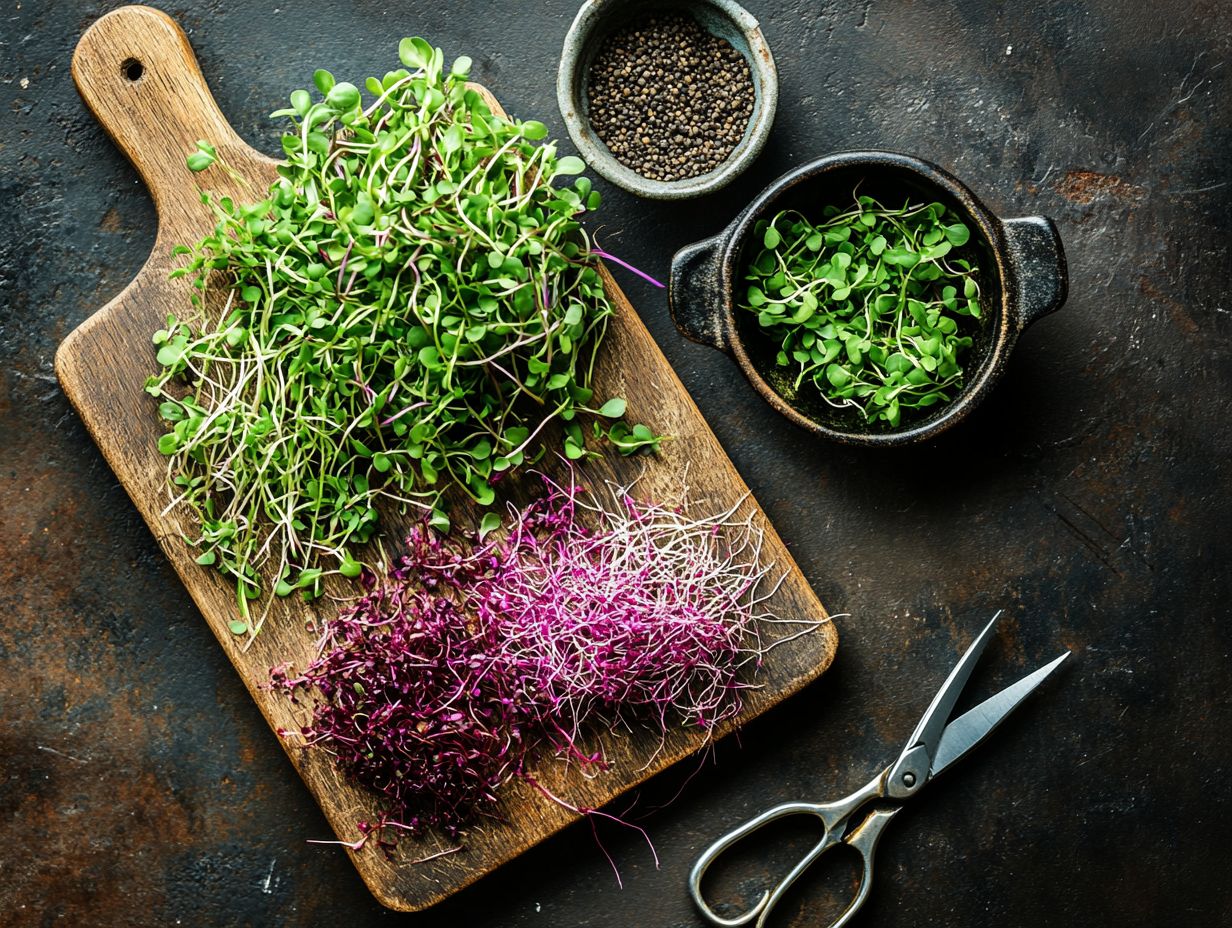
What are microgreens?
Microgreens are young, edible plants harvested after the first few weeks of growth. They are usually around 1-3 inches tall and are packed with intense flavor and nutrients.
Why are microgreens popular in American cuisine?
Microgreens have become popular in American cuisine because of their unique taste, vibrant colors, and health benefits. They are versatile and can be used in various dishes, from salads and sandwiches to desserts.
What are some common types of microgreens used in American cuisine?
Common microgreens include arugula, kale, radish, beet, and sunflower. Many other varieties are available, each with its distinct flavor and texture.
How do I incorporate microgreens into my recipes?
Microgreens can be used as a garnish or added to dishes for a pop of flavor and color. They can also serve as the main ingredient or be blended into smoothies for added nutrients.
What are the health benefits of microgreens?
Microgreens are rich in nutrients, including vitamins, minerals, and antioxidants. They are known for their anti-inflammatory, anti-cancer, and heart-healthy effects.
Are microgreens easy to grow at home?
Yes, microgreens are incredibly easy to grow at home with just a few supplies. You can grow them indoors or outdoors using a shallow container, potting soil, and water.
These tiny plants pack a punch of flavor and nutrition. Microgreens add fresh, healthy ingredients to your meals, making cooking more exciting and delicious!

